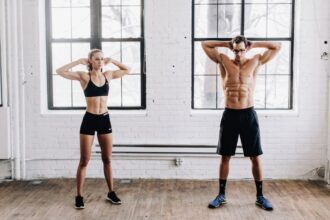Use this practical guide to the San Francisco Elevation Method for Proven Workouts — fourteen workouts built for the city’s hills, waterfront, parks and premium gyms. Each session is designed to help you rise stronger, build resilience, and tap into the energy of the Bay Area.
How to use the San Francisco Elevation Method
The method mixes outdoor conditioning, stair-and-hill work, interval training, bodyweight strength, mobility, and restorative sessions so you build power without burnout. Rotate through the 14 workouts across the week — 4 strength, 4 cardio/hill, 3 mobility/recovery, 2 skill-based, and 1 active-rest day — and you’ll see progress in endurance, force production and daily energy.
For a printable 7-day plan and progress tracker, visit our Workouts page. If you want a coach to customize the method, reach out via Contact.
Workout 1 — Golden Gate Park Strength Circuit
Use the parcourse and grassy berms in Golden Gate Park for a circuit: farmer carries (or loaded backpack) 40–60m, push-up variations, single-leg Romanian deadlift off a curb, and trunk rotations. Rotate 3–5 rounds with short rests to build practical strength and work capacity. Golden Gate Park offers multiple fitness trails and outdoor equipment that are perfect for this format. :contentReference[oaicite:0]{index=0}
Map location: Golden Gate Park — Google Maps

Workout 2 — Crissy Field Wind Sprints & Core
Flat sprint intervals (10 × 40–80m with recovery jogs) followed by a 10-minute core finisher (planks, dead bugs, Russian twists) make Crissy Field an ideal cardio-power playground. The open shoreline gives room for speed work plus stunning views that help sustain motivation. For nearby indoor climbing, Movement Climbing & Fitness is a great complement for mobility and grip strength. :contentReference[oaicite:1]{index=1}
Map location: Crissy Field — Google Maps
Workout 3 — Twin Peaks Hill Repeats
Hill repeats on Twin Peaks (short steep climbs followed by controlled recoveries) build cardiovascular power and leg drive. Aim for 6–8 repeats; finish with a slow descent for active recovery and mobility work at the top to maintain hip and ankle range.
Map location: Twin Peaks — Google Maps
Workout 4 — Filbert Steps Stair Power Session
The Filbert Street Steps and many of San Francisco’s stairways are perfect for stair bounding, step-ups, and plyometric progressions. Use alternating-heavy sets of stair hops and single-leg step-ups for explosive strength and stability. The Filbert Steps are a locally famous stair route used by runners and trainers. :contentReference[oaicite:2]{index=2}
Map location: Filbert Steps — Google Maps
Workout 5 — 16th Avenue Tiled Steps Endurance Builder
Climb the 16th Avenue Tiled Steps in sets: moderate pace climbs followed by controlled descents. Add bodyweight lunges and elevated calf raises at the top to turn a scenic landmark into a powerful lower-body session. The tiled steps are also a superb place for breathing drills at summit viewpoints. :contentReference[oaicite:3]{index=3}
Map location: 16th Avenue Tiled Steps — Google Maps
Workout 6 — Mission Dolores Park Hill & Agility Flow
Drive agility with cone circuits on the park’s slopes, followed by hill skater jumps and light sled or sandbag pushes (improvise with a weighted bag). Mission Dolores Park’s sloping terrain makes it ideal for mixed-speed and agility work. :contentReference[oaicite:4]{index=4}
Map location: Mission Dolores Park — Google Maps
Workout 7 — Marina Green Strength & Row Intervals
Pair intervals on a rowing machine (or erg-style pushes on a rental rower if available) with bodyweight to weighted strength circuits on the Marina Green. The flat waterfront allows stable sprint work and short recovery runs.
Map location: Marina Green — Google Maps
Workout 8 — Beach-Based Mobility & Breathwork
Baker Beach or Ocean Beach are terrific for mobility flows (world-facing breaths, thoracic rotations and banded shoulder drills) and breathwork sessions that prime recovery. Low-impact work by the sea helps regulate the nervous system while restoring movement quality.
Map location: Baker Beach — Google Maps
Workout 9 — Trail Strength at Lands End & Presidio
Combine trail running with bodyweight strength stops (eccentric lunges, step-ups, chin-ups where possible). Presidio and Lands End trails offer varied terrain for single-leg strength and balance practice. For indoor recovery and cross-training, check local climbing and fitness centers near the Presidio. :contentReference[oaicite:5]{index=5}
Map location: Lands End — Google Maps
Workout 10 — Functional Gym Session (Bay Club / Equinox)
For structured strength training, use premium clubs like Bay Club or Equinox for guided barbell cycles, Olympic-style lifts, mobility coaching and recovery amenities (sauna, pools). These clubs combine tools and coached programs to accelerate strength gains. :contentReference[oaicite:6]{index=6}
Map location: Bay Club — Google Maps · Equinox — Google Maps
Workout 11 — Outdoor Calisthenics Park Session
Use pull-up bars, dip stations and parallel bars found in several parks (e.g., the Panhandle and select Golden Gate Park spots) to run progressive calisthenics: negatives, assisted to full-range pull-ups, parallel bar dips and L-hangs. Bodyweight mastery in outdoor fresh air is a staple of the method.
Map location: Calisthenics parks — Google Maps
Workout 12 — Climbing & Grip Strength
Indoor bouldering and climbing (Movement San Francisco at the Presidio is a flagship facility) drastically improve full-body tension, scapular control and grip strength — all transferable to running, lifting and functional life. :contentReference[oaicite:8]{index=8}
Map location: Movement Climbing — Google Maps
Workout 13 — Active Recovery Walk & Mobility Loop
Easy-paced mobility walks (Sutro Forest, coastal promenades) with band work and foam rolling to flush legs and restore tissue health. Keep these sessions intentional but low intensity to support adaptation from the harder days.
Map location: Mount Sutro — Google Maps
Workout 14 — Open-Water Swim & Breath Training
If you have access and experience, join an open-water swim at spots like Aquatic Park or South Beach; pair shorter hard efforts with longer aerobic swims to build breathing economy and calm under stress. Always swim with a buddy or in organized groups for safety.
Map location: Aquatic Park — Google Maps
Weekly structure & sample rotation
Sample week: Mon — Strength (Gym); Tue — Hill repeats (Twin Peaks); Wed — Active Recovery (Mobility loop); Thu — Speed sprints (Crissy Field); Fri — Calisthenics (Panhandle/Golden Gate Park); Sat — Long trail + climbs (Lands End/Presidio); Sun — Open-water swim + breath work. Adjust volume and intensity to match your experience and recovery.
Need a guided 7-day program PDF? Download our downloadable plan and calendar from ihoxi.xyz/workouts.
Safety, gear and local resources
Wear layers (San Francisco microclimates change fast), bring a small first-aid kit, and hydrate. For group classes, bootcamps and certified outdoor trainers, search local directories and community boards — the city’s Rec & Park programs list authorized fitness activities and locations. :contentReference[oaicite:9]{index=9}
Helpful local resources: Movement San Francisco (climbing & fitness), Bay Club and Equinox for gym access and classes, and AllTrails for trail maps and route planning. :contentReference[oaicite:10]{index=10}
Start rising stronger — San Francisco style
The San Francisco Elevation Method blends the city’s hills, parks, waterfront and premium training facilities into a single system for consistent gains. Rotate these 14 workouts, listen to your recovery needs, and lean on local communities for accountability. If you want this article adapted into a printable plan with embedded map pins for every workout, tell us on our contact page.
Sources: San Francisco Rec & Park listings, Movement Climbing & Fitness, Bay Club & Equinox club pages, local guides to stairs & outdoor workout spots. :contentReference[oaicite:11]{index=11}
Embracing San Francisco’s Microclimates
One of the unique challenges of training in San Francisco is the shifting microclimates across neighborhoods. Athletes adapt by layering clothing, carrying hydration packs, and planning workouts that take advantage of fog-cooled mornings or warm afternoon sun. This flexibility not only builds resilience but also adds variety to each training session.
Mind-Body Flow on the Embarcadero
The Embarcadero waterfront is more than a scenic run — it’s a place to practice mindfulness. Incorporating short breathwork breaks or gentle stretching during a jog along the piers creates a mind-body connection that enhances endurance and mental clarity while taking in the city skyline and bay views.
Strength From the Stairs of Telegraph Hill
Telegraph Hill offers some of the city’s steepest stairs, making it a prime training ground for athletes looking to build power. Using the stairs for loaded carries, interval climbs, and lateral step drills transforms a tourist attraction into a functional strength laboratory.
Community Energy at Local Bootcamps
Many parks and open spaces host bootcamps led by local trainers. These group workouts combine social support with structured exercise, giving participants accountability and a shared sense of achievement. The camaraderie of training together keeps people motivated even when the workouts are tough.
Balancing Training With Recovery in Hot Springs
After challenging sessions, athletes often travel just outside San Francisco to soak in natural hot springs. The mineral-rich waters relax tight muscles, accelerate recovery, and provide a meditative atmosphere. This restorative practice complements the intensity of city workouts, ensuring long-term sustainability.
Nutrition Fueled by Local Farmers Markets
San Francisco’s farmers markets offer fresh produce, lean proteins, and nutrient-rich foods that support training demands. Athletes shop local for seasonal ingredients to build meals that enhance performance, showing that nutrition is as much a part of the method as physical training.
Exploring Alcatraz-Inspired Endurance Challenges
Inspired by the famous Alcatraz swim, many endurance athletes train in the Bay’s cold waters to test their limits. The frigid conditions sharpen mental toughness and prepare the body for high-stress events. This gritty practice has become a badge of honor in the local fitness scene.
Harnessing Technology for Smarter Training
Wearable tech like GPS watches, heart-rate monitors, and sleep trackers is widely used by athletes in the city. These tools provide real-time data that helps tailor intensity, recovery, and nutrition strategies to maximize progress without risking overtraining.
Mindful Recovery Through Yoga in the Park
Outdoor yoga sessions in Dolores Park, Alamo Square, and other green spaces provide a restorative balance to intense hill climbs and stair sprints. Yoga enhances mobility, reduces stress, and integrates mindfulness into daily practice, ensuring the body stays supple and resilient.
Adventure Cross-Training With Cycling Routes
Beyond running and stair climbs, cycling the Golden Gate Bridge into Marin or tackling the city’s hilly streets is a favorite cross-training option. These rides improve cardiovascular endurance and leg strength while delivering breathtaking views that make the effort feel rewarding.
Building Resilience in Foggy Mornings
San Francisco’s mornings are often wrapped in thick fog, especially during the summer months. Instead of seeing this as a barrier, many athletes embrace the cool and misty environment as a way to test mental resilience. Training in fog builds focus, reduces overheating, and adds an element of challenge that makes every session more rewarding. It becomes a metaphor for persistence: pushing forward even when the path isn’t clear.
Harborfront Endurance Training
The Ferry Building area offers long stretches of flat pavement ideal for interval runs or endurance circuits. Athletes combine speedwork with bodyweight drills on the piers, creating sessions that sharpen cardiovascular capacity and muscular endurance. The vibrant energy of the harbor, filled with locals and tourists alike, adds motivation to push through the toughest rounds.
Strength and Stability on Lombard Street
Lombard Street, known as the “crookedest street in the world,” doubles as a unique training ground. The winding inclines and sharp turns provide a natural obstacle course for lateral agility drills, balance exercises, and lower-body strength training. Incorporating loaded carries or sprints up its curves creates a workout that challenges both strength and coordination.
Evening Runs Across the Golden Gate Bridge
The Golden Gate Bridge offers one of the most iconic training routes in the world. Athletes time their runs at sunset, experiencing not only breathtaking views but also strong coastal winds that increase resistance. This natural resistance training helps build stamina, lung capacity, and mental grit. The bridge run is both a fitness test and a meditative journey over one of the world’s most famous landmarks.

Agility Drills in Chinatown’s Hidden Alleys
San Francisco’s Chinatown is filled with narrow alleys and hidden staircases, creating an urban playground for agility-focused workouts. Athletes weave through alleys for shuttle runs, plyometric hops, and balance exercises on uneven terrain. Training here not only builds physical agility but also fosters adaptability in unpredictable environments.
Interval Training at the Marina
The Marina District is known for its flat, open stretches of land along the waterfront. Athletes incorporate sprint intervals, resistance band training, and TRX circuits anchored to park fixtures. The open scenery, coupled with fresh ocean air, makes the Marina a go-to spot for high-intensity training sessions that blend cardio and strength seamlessly.
Strength From Coit Tower’s Steps
The iconic Coit Tower is surrounded by steep steps that athletes use for conditioning workouts. Step sprints, lunges, and weighted carries are common routines. The tower’s historic presence adds a cultural depth to the workout, blending fitness with the city’s rich history while providing panoramic views as a reward at the top.
Bodyweight Mastery in the Panhandle
The Panhandle of Golden Gate Park offers open grassy areas and outdoor fitness equipment. Athletes focus on bodyweight mastery — push-ups, dips, pull-ups, and advanced calisthenics routines. These workouts emphasize functional strength, balance, and endurance without the need for heavy equipment.
Cross-Training With Paddleboarding
San Francisco Bay is a hub for paddleboarding enthusiasts. Athletes use this sport to improve core strength, stability, and balance while enjoying the calming waters. Paddleboarding is a unique cross-training method that builds endurance in a low-impact way while engaging the entire body.
Trail Running in Glen Canyon Park
Glen Canyon Park offers rugged trails with elevation changes that challenge runners. Training here builds cardiovascular strength while improving footwork and stability. The natural landscape creates a refreshing escape from the city streets, making it a favorite spot for athletes seeking adventure and endurance training in nature.
Partner Workouts at Yerba Buena Gardens
Yerba Buena Gardens provides a spacious urban environment for partner workouts. Athletes pair up for resistance band drills, medicine ball passes, and synchronized sprints. These workouts not only improve strength and coordination but also foster teamwork, accountability, and motivation through shared effort.
Strength Through Resistance at Fort Mason
Fort Mason’s open grounds are perfect for resistance training. Athletes bring resistance bands, sandbags, and kettlebells to create outdoor strength circuits. The area’s coastal backdrop provides a scenic environment, making even the most demanding sessions feel invigorating.
Cardio Conditioning on Market Street
Market Street’s long stretches are ideal for tempo runs and conditioning circuits. Athletes use landmarks along the street as markers for interval training. The hustle and bustle of the city adds energy to the workout, creating a blend of urban life and athletic focus that challenges mental toughness as much as physical stamina.
Recovery Walks at Lake Merced
Lake Merced offers a tranquil loop trail perfect for recovery walks and low-intensity runs. The calm waters and natural scenery promote relaxation while still keeping the body active. Recovery walks here are often paired with light stretching sessions, helping athletes restore mobility and prepare for the next high-intensity workout.
Balance Training on Ocean Beach
Ocean Beach provides an unstable sandy surface that challenges balance and coordination. Athletes practice single-leg exercises, stability drills, and plyometrics in the sand, which reduces joint impact while increasing muscular engagement. The rhythmic sound of waves adds a meditative element to the training.
Endurance Challenges in Presidio Trails
The Presidio’s network of trails provides an endless canvas for endurance challenges. Athletes tackle long-distance runs, weighted hikes, and interval climbs through wooded terrain. These workouts not only build physical endurance but also immerse participants in the natural beauty of the park, making fitness feel like an adventure.
Power Training at Civic Center Plaza
The open spaces of Civic Center Plaza are ideal for explosive power workouts. Athletes bring medicine balls, kettlebells, or battle ropes for plyometric circuits that enhance explosive strength. Training in a civic space also reflects the city’s blend of culture, community, and athleticism.
Sunrise Yoga at Alamo Square
Alamo Square, known for its iconic Painted Ladies backdrop, is also a favorite spot for sunrise yoga. Athletes and residents gather on the grass for restorative flows that improve flexibility, posture, and mental calm. Practicing yoga here at sunrise connects participants with both nature and the city’s cultural heartbeat.
Strength Endurance on Bernal Heights Hill
Bernal Heights Park offers steep paths that are ideal for strength-endurance circuits. Athletes sprint uphill, perform push-ups or planks at the top, and jog back down for recovery. This cycle tests muscular endurance, cardiovascular power, and mental perseverance, with sweeping views of the city as motivation.
Creative Conditioning in the Mission District
The Mission District’s murals and vibrant streets inspire creative conditioning sessions. Athletes integrate wall sits against colorful murals, agility drills in alleys, and bodyweight strength moves in small plazas. Training here feels like blending art, culture, and athletic performance into one unforgettable experience.
Frequently Asked Questions (FAQs)
What are the most effective Proven Workouts for building overall strength?
The most effective Proven Workouts for strength include compound lifts, bodyweight circuits, and resistance training that target multiple muscle groups at once.
How often should I do Proven Workouts for visible results?
Consistency is key, and doing Proven Workouts at least 4 to 5 times per week helps maximize strength, endurance, and long-term progress.
Can beginners safely follow Proven Workouts without prior experience?
Yes, beginners can start Proven Workouts with scaled-down versions of each exercise and gradually increase intensity under proper guidance.
Do Proven Workouts require expensive equipment?
No, many Proven Workouts rely on bodyweight training, resistance bands, and natural terrain, making them accessible and affordable.
What makes Proven Workouts different from traditional gym routines?
Proven Workouts focus on functional strength, adaptability, and endurance using innovative methods rather than relying only on machines.
How do Proven Workouts improve mental resilience?
Proven Workouts challenge both body and mind by pushing limits, building focus, and developing persistence in tough environments.
Are Proven Workouts suitable for weight loss goals?
Yes, Proven Workouts combine strength training and cardiovascular activity, which increases calorie burn and supports fat loss.
Do Proven Workouts include flexibility and mobility training?
Proven Workouts often integrate yoga, stretching, and balance drills to improve flexibility, prevent injuries, and enhance recovery.
Can Proven Workouts be adapted for outdoor training?
Absolutely, Proven Workouts thrive in outdoor environments such as parks, trails, and beaches where natural resistance adds intensity.
How long does it take to see results from Proven Workouts?
With consistent effort, noticeable results from Proven Workouts typically appear within 6 to 8 weeks, depending on intensity and lifestyle.
What role does nutrition play in maximizing Proven Workouts?
Proper nutrition fuels energy, aids recovery, and enhances performance, making it essential for success with Proven Workouts.
Can Proven Workouts be customized for athletes of different sports?
Yes, Proven Workouts are adaptable and can be tailored to meet the specific needs of runners, swimmers, cyclists, and team-sport athletes.
Are Proven Workouts safe for older adults?
With modifications and professional guidance, Proven Workouts can be safe and effective for older adults seeking strength and mobility.
Do Proven Workouts help improve cardiovascular health?
Yes, Proven Workouts that combine interval training and endurance runs significantly boost heart health and lung capacity.

What recovery methods complement Proven Workouts?
Active recovery, stretching, foam rolling, and proper sleep are essential practices that enhance the benefits of Proven Workouts.
Can Proven Workouts be done at home with limited space?
Yes, Proven Workouts can be designed for home training by using bodyweight exercises, compact equipment, and short circuits.
Do Proven Workouts help improve athletic performance?
Proven Workouts enhance agility, strength, and endurance, making them an excellent foundation for boosting overall athletic performance.
How do Proven Workouts support mental health?
By reducing stress hormones, improving focus, and promoting endorphin release, Proven Workouts have a strong positive effect on mental health.
Are Proven Workouts better performed in groups or solo?
Proven Workouts can be effective both in group settings, where accountability drives motivation, and solo sessions that build self-discipline.
What is the biggest advantage of following Proven Workouts consistently?
The biggest advantage of Proven Workouts is the development of long-term physical resilience, stronger mental discipline, and improved overall health.






